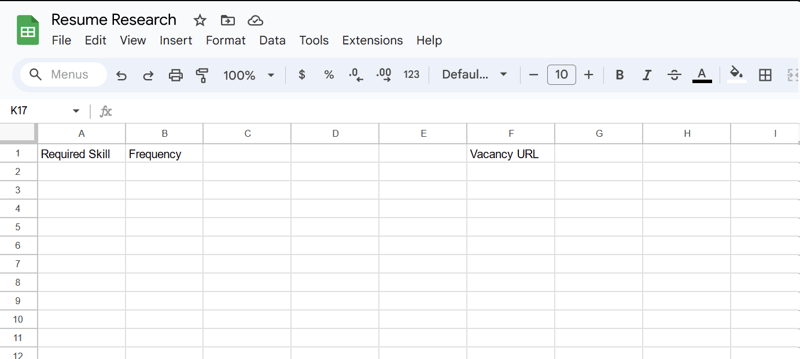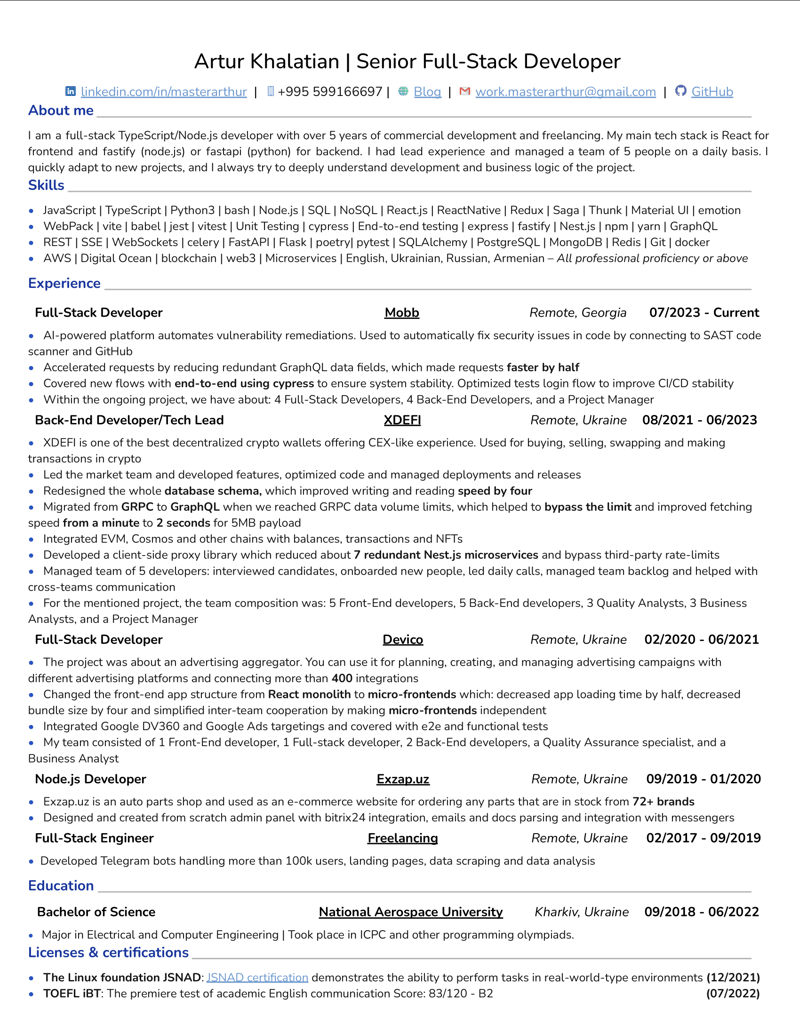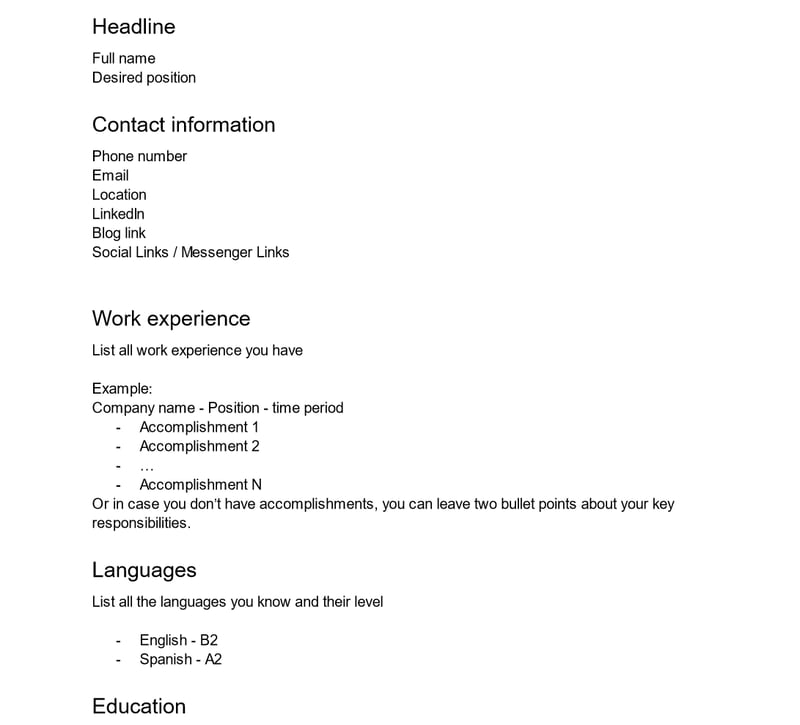As I wrote in my previous article about the importance of a Resume, almost everyone needs one. I've also provided some key points you should follow to increase your job application chances, so I'd recommend reading it first.
In this article, I'm going to provide you an ultimate step-by-step guide on how to write a professional resume based on more than 20 resumes I've made for different fields. This guide will suit well for IT-related specialties, but also works to non IT-related roles.
We will go through three steps: 1 - research, 2 - all data composition, and 3 - formatting. In the first step we will research the job market to have better keywords in our resume, in the second step we will fill our data into one document which at the last step will be formatted into the pretty form you'd like.
Want to check out what is a result we're gaining to? Scroll to the end of the article: I've placed my own resume there. If you like it - this post is for you!
Step 1 - Research
The first and best tool you need to create a resume is Google Sheets. Yes, Excel/Sheets are your very first tools for resume creation, not Google Docs nor Word. You would ask "why?", and the answer is simple: every good work starts from research.
Foremost, we need to create a spreadsheet document with three columns: Required skill, Frequency and a separate column Vacancy URL:

You can copy the template from here
Also, we will have to use job board websites, like LinkedIn or Indeed. There probably can be some other websites which are used in your region, so it's better to do some research on it and find out what suits your situation the most.
Now we're ready to start. Use at least two-three job boards, apply filters regarding your desired position/location/experience. It's better to go as specific on position names as possible. "Software Engineer" can give you many types of software engineering, so you will have to scan numerous totally different vacancies, which is not good for research and its results.
If you don't have any work experience, and there are less than 30 vacancies for non-experienced, set 1–2 years in filters to have more vacancies for research. Also, companies are ready to review your resume in some cases and help you on the onboarding stage depending on skills you have: like good knowledge of some language, knowledge of some fields like physics, marketing, food cooking etc.
After setting all the required filters, we go one-by-one and scan vacancies for requirements. Fill them into your document, or increase the number if you have already seen this requirement. Save vacancy links, it will be very handy in the future. We must go through as many vacancies as we can (or the top 30-40 in total) from different sources. You can go with a more significant number, but it will not make a big difference if you have a specific position name like "React.js Front-End Developer".
Your document will look like this:

You will have way more skills in the document, it's just an example
If there are very frequent skills, but you are not sure if you have them, it would be very useful to spend some time on testing these skills or gaining additional education to fit the required level. For example: if Spanish is a common requirement, but your Spanish is only "¡Hola!", you will have an advantage if you increase your knowledge at least to an average level like A2 or B1.
So now the research step is finished, we're ready for the next step.
Please share your research results with your filters in the comments to make everyone else's work easier!
Step 2 - Fill all the data
When the research is finished, it's time to fill the data and use suitable tools for resume creation: Google Docs or Word (or any popular text redactor). Create a blank document or use this template. This document will accumulate all the ACTUAL experiences and skills you have.
Add these sections to the document:
- Headline - required
- Contact information - required
- Work experience - required
- Languages - required, but can be merged with skills block
- Education - required
- Certifications and licenses - if you have them
- Publications - if you have scientific publications; for bloggers, you can skip it and place URL to your blog in the contact block
- Awards - if you have them
- Volunteer work - optional
- Summary - required
- Skills - required
Fill the document one by one following this guide because THE ORDER MATTERS. This order lets you achieve the correct structure of information and focus on the most important parts.
This template also contains a couple of examples to make it easier to fill.
Headline
This section is easy to fill. It's just your full name (like in your documents) and desired position name which could be found in vacancy headlines, for ex: "Manual QA".
Contact information
Second easy to fill section. The most important thing here is relevancy. All contact data should be relevant and actual, so the recruiter should be able to contact you with this data. Your phone number, email and work location are important to specify. For remote workers, you can also specify the location or time-zone of remote work, for example "Remote/Germany".
Work experience
The most important section of every resume is the work experience section. All other sections could be skipped by recruiter easily if your experience is relevant and outstanding. Here you should list in reverse chronological order all your relevant workplaces, positions, time period and your results and achievements. Don't forget that results matter more than responsibilities, they make the difference between developers who fix features and implement bugs. All results should be short, precise and include numbers. It can be started from one of the resume buzzword, for example:
- Redesigned the whole database structure, which improved writing and reading speed by four
Also, use bullet points instead of solid text to divide multiple results in the experience section, and highlight keywords and numbers in bold to attract attention. Bullet points increase readability drastically. Just compare:
Redesigned the whole database schema, which improved writing and reading speed by four. Migrated from GRPC to GraphQL when we reached GRPC data volume limits, which helped to bypass the limit and improved fetching speed from a minute to 2 seconds for 5MB payload. Developed a client-side proxy library which reduced about 7 redundant Nest.js microservices and bypass third-party rate-limits
and:
- Redesigned the whole database structure, which improved writing and reading speed by four
- Migrated from GRPC to GraphQL when we reached GRPC data volume limits, which helped to bypass the limit and improved fetching speed from a minute to 2 seconds for 5MB payload
- Developed a client-side proxy library which reduced about 7 redundant Nest.js microservices and bypass third-party rate-limits
If you don't have at least three measurable results, you can include your key responsibilities, but don't forget that measurable results are way preferable. Also, you can add one bullet point to write a small description of the workplace or project where you have worked.
Languages
This is a required section. However, you can skip it just by moving your languages to the skills section like this:
But if you have enough space for it in your resume, you can just list all your languages with knowledge level at least on A2, in case they're relevant for your job application.
Education
In the education section you just list all the places where you have studied, its names, locations and time periods. If you have a high degree in one field, then just include the highest and don't include your elementary or middle school. If you have passed specialized courses, you can also include them. You also can specify one bullet on your most interesting achievement: like top place in Olympiad, scientific publication, high GPA score, etc.
Certifications and licenses / Publications / Awards
These three sections are optional, but if you have awards, certifications, scientific publications, they will highlight you from a dozen other resumes. The format is pretty obvious: bullet points with certification/award/publication names and dates.
Volunteer work
The format of this section is almost the same as work experience's format, but this section is optional most of the time. However, if volunteer work is valued for your position or field, then you have to fill it too.
Summary
The objective of a resume summary is to accentuate elements related to the position you are seeking, which are not detailed elsewhere in your resume. This includes showcasing transferable skills, high-level accomplishments or a context that makes your accomplishments stand out. Also, you can specify your motivation and what you're looking for.
Skills
The Skills section is a keyword section. It's used for resume search and matching. The better keywords you have, the higher are your chances to appear in the search results. To build a correct list of skills, you will need all the frequent required skills from Step 1 - Research, and you can add skills from your already described work experience, education and other sections. Add only relevant skills and skip all the cliché skills like "Team player" or "Result-driven".
Step 2.1 - Spellcheck
Use some spellcheck tools like Grammarly or LanguageTool to fix all possible typos. It's an IMPORTANT step. If your resume has typos, it will decrease your chances drastically.
And we've finished the second step. Now we have all the necessary data in one document. And it's time for formatting!
Step 3 - Formatting
The main goal of the formatting step is to format all the most important data in one page in a readable style with Application Tracking System (ATS) compatibility. You can try two pages if you have a lot of relevant work experience, but one page is always preferable. If you can remove some optional sections or shorten them to fit everything in one page, it's better to do so.
File format
The resume should look the same both in .docx and .pdf formats. PDF is more common. However, sometimes ATS could require .docx format, so having them both is an ultimate move.
Template
The right template is important for a professional resume. So there are three main requirements for a resume template: readability, style and ATS-compatibility. The readability requirement is challenging to estimate until you fill all the necessary data, but if you pick an ATS-compatible template, it's going to be human-readable in most cases with all the relevant data. The style requirement is determined by your seniority and the work field. If you work in design, you can showcase some "bells and whistles" in your resume, but in most other cases a minimalistic style will work better.
You can use templates from these lists:
In the next article I will share you some more advices about resume styling, so be sure to follow my dev.to blog
Template filling
Now we have our resume template selected and data prepared from the previous step. The template can be filled with your data and converted to your personal resume. You can rearrange sections, but most of the time they're in traditional order.
And we're done. We have our professional resume prepared to be used in your job application.
Extra Step 4 - Application
It's time for the extra step: remember that your resume was built using vacancy descriptions? Use the links you saved in Step 1 and apply for these vacancies. You will have a pretty high chance of passing the resume filter and being invited to the interview, which will help you to test your skills and boost yourself.
My resume
Here is my resume! I built it by using my own guide and following steps I've described:

Here you can find it on Google Docs and make your own copy.
For those who didn't know, I've started my own private consultations! More than that, I regularly help people in creating good resumes from scratch or using existing ones. So check out my Telegram channel for more information!
Be sure to follow my dev.to blog and Telegram channel; there will be even more content soon.






















